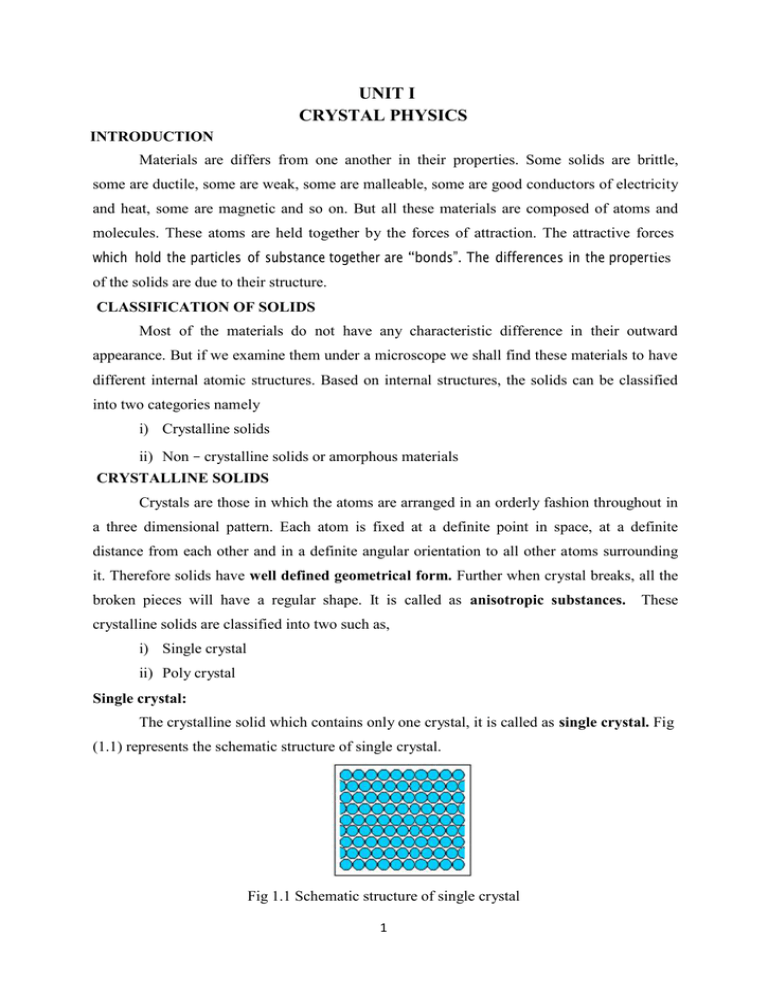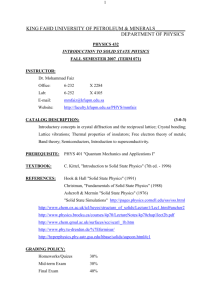lattice, unit cel,Bravais lattice, lattice planes
advertisement

UNIT I CRYSTAL PHYSICS INTRODUCTION Materials are differs from one another in their properties. Some solids are brittle, some are ductile, some are weak, some are malleable, some are good conductors of electricity and heat, some are magnetic and so on. But all these materials are composed of atoms and molecules. These atoms are held together by the forces of attraction. The attractive forces which hold the particles of substance together are “bonds”. The differences in the properties of the solids are due to their structure. CLASSIFICATION OF SOLIDS Most of the materials do not have any characteristic difference in their outward appearance. But if we examine them under a microscope we shall find these materials to have different internal atomic structures. Based on internal structures, the solids can be classified into two categories namely i) Crystalline solids ii) Non – crystalline solids or amorphous materials CRYSTALLINE SOLIDS Crystals are those in which the atoms are arranged in an orderly fashion throughout in a three dimensional pattern. Each atom is fixed at a definite point in space, at a definite distance from each other and in a definite angular orientation to all other atoms surrounding it. Therefore solids have well defined geometrical form. Further when crystal breaks, all the broken pieces will have a regular shape. It is called as anisotropic substances. These crystalline solids are classified into two such as, i) Single crystal ii) Poly crystal Single crystal: The crystalline solid which contains only one crystal, it is called as single crystal. Fig (1.1) represents the schematic structure of single crystal. Fig 1.1 Schematic structure of single crystal 1 Poly crystal: The polycrystalline materials are aggregate of many grains separated by well defined grain boundary. Fig (1.2) represents the schematic structure of poly crystal. Fig 1.2 Schematic structure of poly crystal NON – CRYSTALLINE SOLIDS (AMORPHOUS MATERIALS) Amorphous means without form. The materials in which atoms are arranged in an irregular fashion are known as amorphous materials. Example: rubber, glass and plastics. The schematic representation of amorphous materials as shown in fig 1.3 Fig 1.3 Structure of amorphous materials DIFFERENCES BETWEEN CRYSTALLINE AND NON – CRYSTALLINE MATERIAL S. No 1. Non – Crystalline Material Crystalline Material They have a definite and regular They do not have definite and regular geometrical shapes which extend geometrical shape throughout the crystal 2. They are anisotropic They are isotropic 3. They are most stable They are less stable 4. They have sharp melting point They do not have sharp melting point 5. Examples: NaCl, KCl Examples: Glasses, Rubber FUNDAMENTALS OF CRYSTALS AND ITS STRUCTURES Crystal: A crystal is a three dimensional solid which consists of periodic arrangement of atoms. Crystal is regular polyhedral form bounded by smooth surfaces, which is formed by 2 chemical compound under the action of its inter atomic forces, when passing from the state of liquid to that of a solid, under suitable condition. X –rays are most widely used to study the crystal structures, because the wavelength of X –rays are almost equal to that of the inter atomic distances. Crystallographic terms: A crystal is a collection of atoms in three dimensions. As a matter of convenience, these atoms are considered as points to study the crystal structure. The representation of atoms in the crystals as points in three dimensions is known as space lattice. Lattice: Lattice is a geometrical concept. It is defined as an array of points which are imaginarily kept to represent the position of atoms in the crystal such that every lattice point has got the same environment as that of the other and hence one lattice point cannot be distinguished from the other point. Lattice plane: A set of parallel and equally spaced plane in space lattice is defined as lattice plane and is as shown in figure (1.4). Lattice point Lattice line Fig 1.4 Fig 1.5 Lattice point: The atom in the crystal is replaced by the point is called as lattice point and is as shown in figure (1.5). Lattice line: The lattice points are joined with the lines as shown in figure (1.5). These lines are known as lattice line. Basis (motif): The crystal structure is obtained by adding a unit assembly of atoms to each lattice point. This unit assembly is called as motif (or) basis. The number of atoms in the basis may be 1 or 2 or 3.etc and it may be go even above 1000 which are identical in composition,arrangement and orientation. Example, Aluminium and Barium has the basis of 3 the one atom, NaCl and KCl has the basis of the two atoms and CaF2 has the basis of the three atoms. Crystal structure: When the basis is repeated in a space lattice with correct periodicity in all directions, then it gives the actual crystal structure. Therefore, a space lattice combines with a basis gives a crystal structure. (i.e.,) Space lattice + Basis = Crystal Structure. Unit cell: It is defined as the smallest volume of a solid from which the entire crystal structure is constructed by translation repetition in the three dimensions. The unit cell fully represents the characteristics of entire crystal. A unit cell in three dimensions is shown in fig. 1.6. Fig. 1.6 Lattice parameters of the unit cell: A unit cell is constructucted if the distance between two neighbouring lattice points along three dimensions and angle between them are known. The distance between two neighbouring lattice point is nothing but the edges of the unit cell. The lengths OA, OB, OC in three axes OX, OY and OZ are the axial lengths or intercepts.(fig 1.7). In fig 1.7 the axial lengths OA = a, OB = b and OC=c are known as intercepts a, b and c along three axes. The angles between three intercepts (α, β and γ) are called interfacial angles. Therfore, the both intercepts and interfacial angles are the lattice parameters of the unit cell. They determine the actual shape and size of the unit cell. Fig 1.7 4 Primitive cell & Non - Primitive cell: A primitive cell is the simplest type of unit cell which contains only one lattice points or atom per unit cell. Example: simple cubic. Non - primitive cell: If there are more than one lattice points in a unit cell, it is called a non - primitive cell. Example: BCC and FCC. THE CRYSTAL SYSTEMS On the basis of lattice parameters such as intercepts or axial lengths (a, b & c) and interfacial angles (α, β and γ) the crystals are classified into 7 crystal system. The 7 basic crystal systems are 1. Triclinic 2. Monoclinic 3. Orthorhombic 4. Tetragonal 5. Hexagonal 6. Trigonal (or) Rhombohetral 7. Cubic 1. Triclinic crystal system: In this crystal system, all three axial lengths of unit cell are not equal and all the axes are inclined obliquely to each other (fig 1.8 a). Example: Copper Sulphate (CuSo4), Potassium dichromate (K2Cr2O7) 2. Monoclinic crystal system: In this crystal system, all three axial lengths of unit cell are not equal. Two axes are perpendicular to each other and third is obliquely inclined (fig 1.8 b). Example: Sodium Sulphate (Na2So3), Ferrous Sulphate (FeSo4) 5 3. Orthorhombic crystal system: In this crystal system, all three axial lengths of unit cell are not equal but they are perpendicular to each other (fig 1.8 c). Example: Sulphur, Topaz 4. Tetragonal crystal system: In this crystal system, two axial lengths of the unit cell are equal and third axial length is either longer or shorter (fig 1.8 d). but they are perpendicular to each other Example: Ordinary white tin, Indium 5. Hexagonal crystal system: In this crystal system, two axial lengths of the unit cell are equal and lying in one plane at 120˚ with each other. The third axial length is either longer or shorter than the other two and it is perpendicular to this plane (fig 1.8 e). Example: Quartz, Tourmaline. 6. Trigonal (or rhombohedral) crystal system: In this crystal system, all three axial lengths of unit cell are equal. And also they are equally inclined to each other at an angle other than 90˚ (fig 1.8 f). Example: Calcite 7. Cubic crystal system: In this crystal system, all three axial lengths of unit cell are equal and they are perrpendicular to each other (fig 1.8 g). Example: Sodium Chloride (NaCl), Calcium Fluoride (CaF2) 6 Table 1.1 Seven crystal systems S.No Crystal systems Axial lengths (a, b, c) Interfacial angles (α, β, γ) Example 1 Triclinic a ≠b ≠c α≠ β ≠ γ ≠ 90 CuSo4, K2Cr2O7 2 Monoclinic a ≠b ≠c α = β = 90˚ , γ ≠ 90˚ Na2So3, FeSo4 3 Orthorhombic a ≠b ≠c α =β = γ = 90˚ Sulphur, Topaz 4 Tetrahedral a =b ≠c α =β = γ = 90˚ Ordinary white tin, Indium 5 Hexagonal a =b ≠c α = β = 90˚ , γ = 120˚ Quartz, Tourmaline 6 Trigonal (or) Rhombohedral a=b=c α = β = γ ≠ 90˚ Calcite 7 Cubic a=b=c α = β = γ = 90˚ NaCl, CaF2 BRAVAIS LATTICE In 1880 Bravais introduced the concept of space lattice. He showed that there are only 14 ways of arranging points in space such that the environment looks same from each point. Hence, there are only 14 types of space lattices which can be possibly developed from 7 crystal systems as shown in table (1.2). These 14 types of space lattices are known as Bravais lattice. Table 1.2 Possible Bravais Lattice Crystal No.of possible S.No systems Bravais Lattices 1 2 3 Triclinic Monoclinic Orthorhombic 1 2 4 4 5 Tetrahedral Hexagonal Trigonal (or) Rhombohedral Cubic 2 1 Total 14 6 7 1 3 The 14 possible Bravais lattices drawn from the crystal systems are shown in table 1.3. 7 Table 1.3 Bravais lattices of seven crystal systems S. No Crystal systems 1 Triclinic ( a ≠ b ≠ c, α ≠ β ≠ γ ≠ 90 ) 2 Monoclinic (a ≠ b ≠ c, α = β = 90 , γ ≠ 90 ) 3 Orthorhombic ( a ≠ b ≠ c, α = β = γ = 90 ) 4 Tetrahedral (a = b ≠ c, α = β = γ = 90 ) 5 6 7 Bravais Lattices Hexagonal (a = b ≠ c, α = β = 90 , γ ≠ 120 ) Trigonal (or) Rhombohedral (a = b = c, α = β = γ ≠ 90 ) Cubic (a = b = c, α = β = γ = 90 ) 8 9






